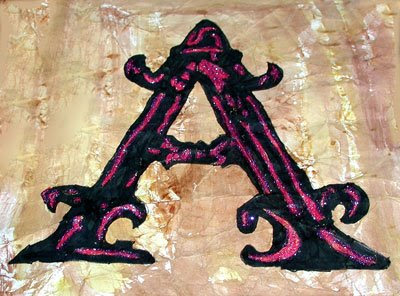

While the common designation given to Rufillus by scholars is illuminator or decorator, the second selfie suggests that he was also a scribe. Rufillus’ name in Amiens, Bibliothèque municipale, Lescalopier 30, fol. By showing himself applying red paint on the letter R he invites the beholder in his atelier, which is a powerful gesture. In a rather unusual twist, we witness both the artist at work and the result of his toils.

That hand is in turn supported by a stick placed on the ground – a selfie-stick! With a healthy dose of irony, Rufillus allows us to observe him as he is painting the initial he is inhabiting. In what is a familiar pose for painters today, his right hand is leaning on his left for stability. Cow horns filled with all kind of paints are placed behind him, while a mortar and pestle are placed nearby for preparing additional pigments. In one hand Rufillus is holding a bowl filled with red paint in the other a brush. The scene is unusually rich in detail and shows us, among other things, what tools were used by medieval illuminators. The Cologny manuscript shows the artisan “in the moment,” hard at work decorating the manuscript (Figure 2). In his article Michon shows, by highlighting iconographical – design – parallels, that it is the same person who produced the decoration in both manuscripts. Judging from the decoration in the two manuscripts, which include numerous decorated initials and even some full-page miniatures, he was quite accomplished. In secondary literature he is commonly regarded (and explicitly labeled as) an illuminator (see for example here and here). Based on the origins of the two manuscripts, scholars place Rufillus in the late-twelfth century Premonstratensian abbey of Weissenau near Ravensburg in the South of Germany (get up to speed on Rufillus in this article by Solange Michon a useful enumeration of manuscripts from Weissenau is found here). Helpfully, Rufillus identifies himself by providing his name: in the Cologny manuscript he painted it in white above his brush (accompanied by “Fr.” for frater, monk), while in the crowded Amiens initial the name is written right above the decorative letter with pen and ink. Rufillus inside a letter R (Cologny, Fondation Martin Bodmer, Cod.

This post explores what we can learn from the two self-portraits of a monk who is a bit of a showoff – and who is not shy about using the selfie-stick. Selfies are not frequently encountered in medieval manuscripts, which makes the Rufillus case quite special, given that it entails not one but two “snapshots” of the same person.

Here, Rufillus created a more roomy environment, painting himself inside a very large letter R at the outset of the passion of St Martin of Tours (d. Bodmer 127, a collection of saints’ lives kept in the Fondation Martin Bodmer in the Swiss city of Cologny (The Passionary of Weissenau, Figure 2). Rufillus inhabiting a letter D (Amiens, Bibliothèque municipale, Lescalopier 30, fol. Why he shows himself here, when the Hexaemeron is about to discuss the creation of plants and material forms, is unclear. The text discusses the six days of the Creation and Rufillus displays himself inside a green – and rather confined – initial letter D at the outset of the section on the Third Day. One is found in a copy of Ambrose’s Hexaemeron kept in the Bibliothèque municipale in Amiens as MS Lescalopier 30 (Figure 1). That earlier blog post includes two intriguing selfies made by the same person, a monk who calls himself Rufillus. Other medieval examples of selfies are those by Matthew Paris, the thirteenth-century monk from St Albans, painted in the lower margin of his Historia Anglorum (see here). They did so to identify themselves as the creator of a miniature or historiated initial, or even to exhibit their accomplishments as businessmen, as the early-sixteenth-century commercial illustrator Nicolaus Bertschy appears to do. As shown in a previous post on medieval selfies, some decorators made self-portraits in manuscripts, showing that the practice predates print – albeit without the use of a camera. Selfies are by no means an exclusively modern phenomenon.


 0 kommentar(er)
0 kommentar(er)
